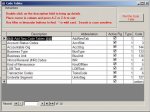I am developing a database that could potentially have more than 50 reference tables with approximately 10 – 20 entries in each reference table.
I was considering combining the reference tables into one reference table, however I have never used this approach and have not been able to find any discussion on the pro’s and cons of using a single reference table or any info on “How to” implement such a design.
I would appreciate learning of others experiences in using a single reference table approach and suggestions on how to implement.
Thanks in advance for your help.
I was considering combining the reference tables into one reference table, however I have never used this approach and have not been able to find any discussion on the pro’s and cons of using a single reference table or any info on “How to” implement such a design.
I would appreciate learning of others experiences in using a single reference table approach and suggestions on how to implement.
Thanks in advance for your help.

